Keywords
|
| Efficiency, Cooling, Tracking, Optical filters |
INTRODUCTION
|
| 1.1 General: The development of new energy sources is continuously enhanced because of the critical situation of the nonrenewable fuels such as oil, gas and others. Thus Renewable energy sources have become a more important contributor to the total energy consumed in the world. In fact, the demand for solar energy has increased by 20% to 25% over the past 20 years. The market for PV systems is growing worldwide. In order to get benefit from the application of PV systems, research activities are being conducted in an attempt to gain further improvement in their cost, efficiency and reliability. With no pollutant emission, Photovoltaic cells convert sunlight directly to electricity. The basic idea of a solar cell is to convert light energy into electrical energy. The energy of light is transmitted by photons, small packets or quantum of light. Electrical energy is stored in electromagnetic fields which in turn can make a current of electrons flow. Thus a solar cell converts light (a flow of photons) to electric current (a flow of electrons). |
| 1.2 Existing system: The existing PV system is a better choice than other sources but suffers from major defect of low efficiency. Currently the best achieved sunlight conversion rate (solar module efficiency) is around 17.4% in new commercial products. |
| 1.3 Proposed system: One of the unique features of photovoltaic modules is the power drop that occurs as the silicon temperature increases due to the characteristics of the crystalline silicon used in a solar cell. To overcome this reduction in power, module surface cooling using water circulation was employed. The model performance was then conceptually evaluated and experimentally verified. The surface cooling system also washed the module surface via water circulation, which resulted in an additional power up of the PV module in response to removal of the particles that interfere with solar radiation from the surface of the PV module. Accordingly, the cooling system could reduce maintenance costs and prevent accidents associated with cleaning. In addition, the increase in cooling water temperature can serve as a heat source. Also it provides tracking of Sun with LDR based circuit to provide higher insolation with respect to the movement of the Sun. The system developed here can be applied to existing Photovoltaic power generation facilities without any difficulties as well. |
PV CELL MODEL
|
| The equivalent circuit of a PV cell is shown in Fig: 2.1. It includes a current source, a diode, a series resistance and a shunt resistance. |
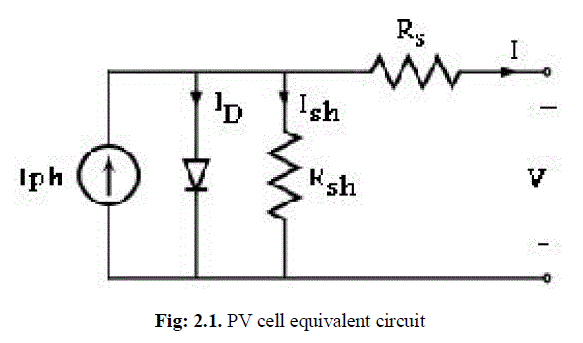 |
| In view of that, the current to the load can be given as |
 |
| In this equation, Iph is the photocurrent, Is is the reverse saturation current of the diode, q is the electron charge, V is the voltage across the diode, K is the Boltzmann’s constant T is the junction temperature, N is the ideality factor of the diode and Rs and Rsh are the series and shunt resistors of the cell respectively. |
EFFECT OF TEMPERATURE VARIATION
|
| Solar cells are sensitive to temperature. Increases in temperature reduce the band gap of a semiconductor, thereby effecting most of the semiconductor material parameters. In a solar cell, the parameter most affected by an increase in temperature is the open-circuit voltage. As the temperature increases, the open-circuit voltage decreases, thereby decreasing the fill factor and finally decreasing the efficiency of a solar cell. It is recommended to operate at 25oC.The power output for different operating temperatures is shown in Figure 3.1 |
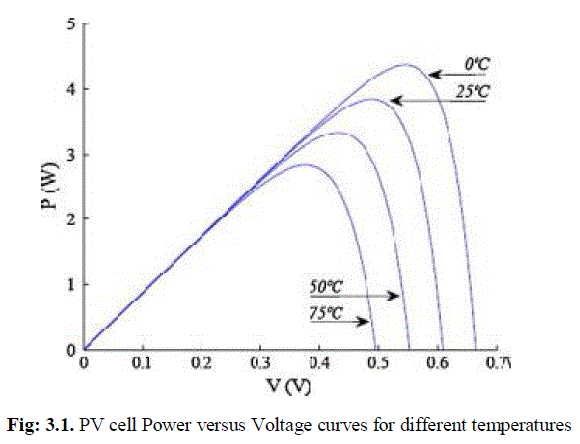 |
| The diode reverse saturation current varies as a cubic function of the temperature and it can be expressed as: |
 |
| where, Is is the diode reverse saturation current , Tnom is the nominal temperature, T is the junction temperature, N is the ideality factor of the diode , Eg is the band gap energy of the semiconductor and Vt is the thermal voltage. In general, for a given solar radiation, when the cell temperature increases, the open circuit voltage Voc drops slightly, while the short circuit current increases. |
| One of the main obstacles that face the operation of photovoltaic panels is overheating due to excessive solar radiation and high ambient temperatures. Overheating reduces the efficiency of the panels dramatically. The P-V characteristics is the relation between the electrical power output P of the solar cell and the output voltage V, while the solar irradiance E, and module temperature Tm, are kept constant. If any of those two factors, namely Tm and E, are changed the whole characteristics change. The maximum power output from the solar cells decreases as the cell temperature increases. Thus the heating of the PV panels can affect the output of the panels significantly. |
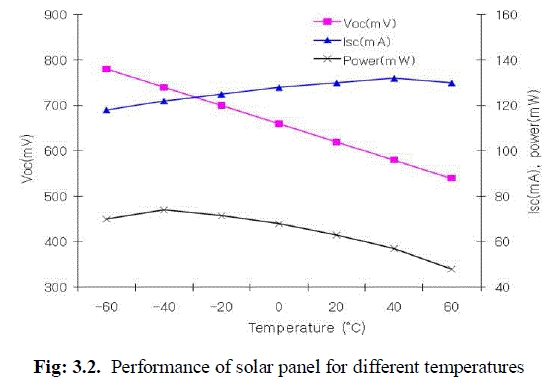 |
EFFECT OF SOLAR RADIATION VARIATION
|
| The term irradiance is defined as the measure of power density of sunlight received at a location on the earth and is measured in watt per metre square. Irradiation is the measure of energy density of sunlight. As the solar insolation keeps on changing throughout the day similarly I-V and P-V characteristics varies. With the increasing solar irradiance both the open circuit voltage and the short circuit current increases and the maximum power point varies. The light intensity on a solar cell is called the number of suns, where 1 sun corresponds to standard illumination 1 KW/m2. Solar cells experience daily variations in light intensity, with the incident power from the sun varying between 0and 1 KW/m2. |
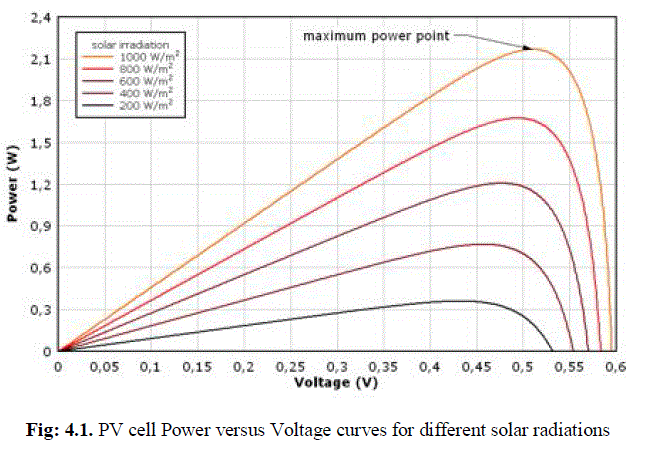 |
HARDWARE IMPLEMENTATION
|
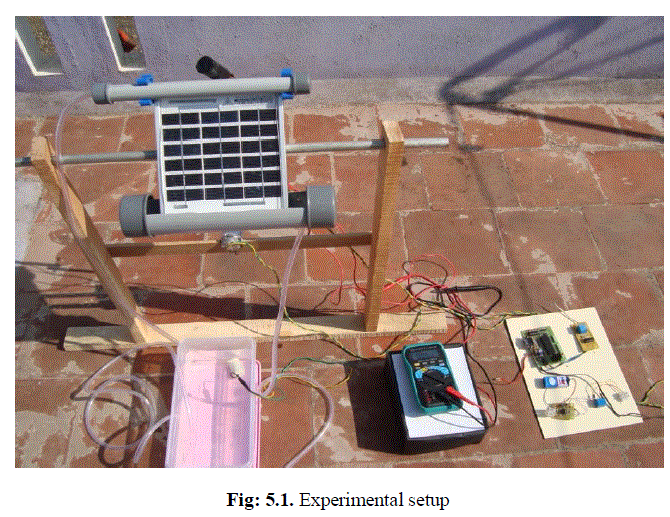 |
| The hardware consists of two parts: |
| 1. Cooling unit |
| 2. Solar tracking unit |
| 5.1 Cooling unit: This unit consists of LM 35, a temperature sensor interfaced with PIC and place over the panel. When the temperature of panel reaches above 35°C (i.e., above the standard temperature conditions), then LM 35 senses it and send a signal to PIC. Then PIC controller will send a signal to relay to turn on for 30 seconds, which in turn will excite the DC pump to pump water from the tank. This water not only cools the panel but also cleans it. Then the used water is returned to the tank. After cooling the panel again the temperature is sensed and the cycle is repeated. It saves energy as well as water by utilizing DC pump and water only when the temperature is elevated. |
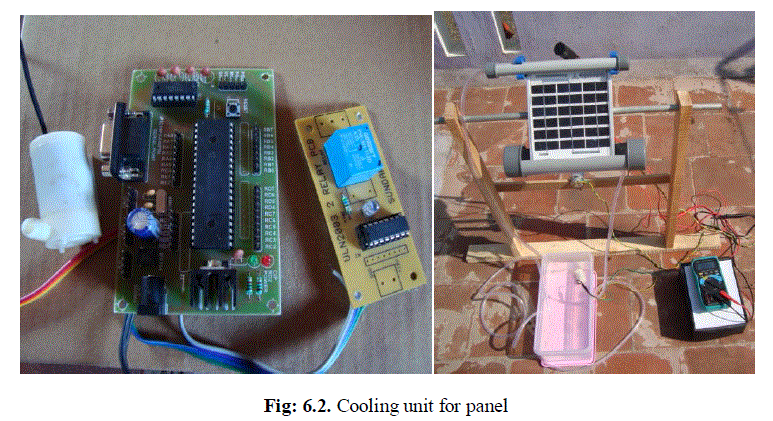 |
| 5.2 Solar tracking unit: This hardware unit has a LDR circuit fitted on the panel. When it is dark or no sufficient light fall on the LDR fitted with the panel, it will excite a relay and hence a DC motor whose mechanical setup will move the panel in such a direction to provide better solar insolation. The motor will be moving the panel till the enough solar radiation is obtained by the panel. |
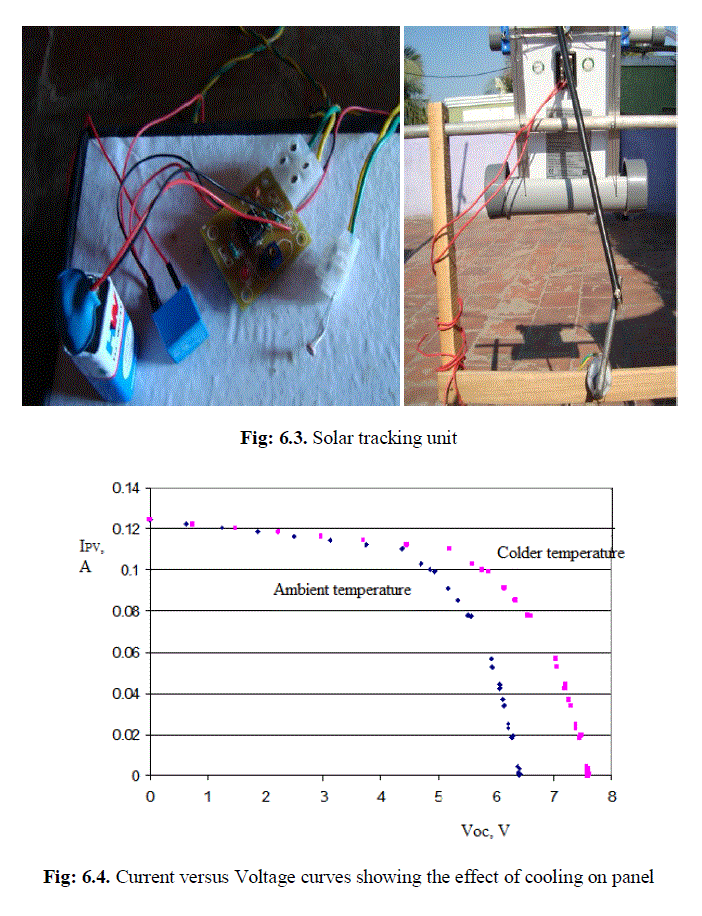 |
 |
| Using air as a coolant was found to decrease the solar cells temperature by 4.7 °C and increases the solar panel efficiency by 2.6%, while using water as a coolant was found to decrease the solar cells temperature by 8 °C and the panel efficiency by 3%. Therefore, cooling by water was found to be more effective than cooling by air. |
ANALYSIS WITH OPTICAL FILTERS
|
| 6.1 Optical filters: Optical filters selectively transmit light in a particular range of wavelengths that is colours, while blocking others. Depending on construction, photovoltaic modules can produce electricity from a range of frequencies of light, but usually cannot cover the entire solar range (specifically, ultraviolet, infrared and low or diffused light). Hence much of the incident sunlight energy is wasted by solar modules, and they can give far higher efficiencies if illuminated with monochromatic light. Therefore, another design concept is to split the light into different wavelength ranges and direct the beams onto different cells tuned to those ranges. This has been projected to be capable of raising efficiency by 50%. |
| 6.2 Effect of frequency of light on solar insolation: In general solar insolation depends greatly depends on frequency (inverse of wavelength) of light that fall on the panel. This can be depicted mathematically as follows: |
| From Planck’s law for black body, |
 |
| where, I = power per unit area(W/m2), h=planck’s constant, v =frequency of radiation, c=velocity of light in vaccum, k=Boltzmann constant, T=absolute temperature. Also I is approximately equal to β(solar insolation) |
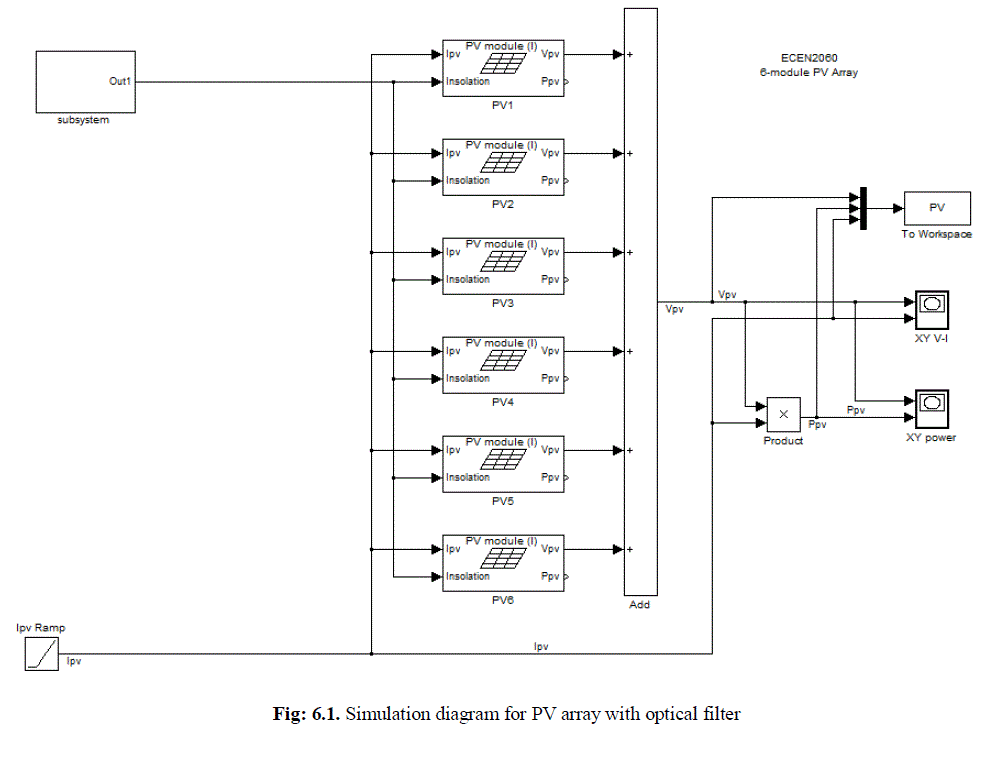 |
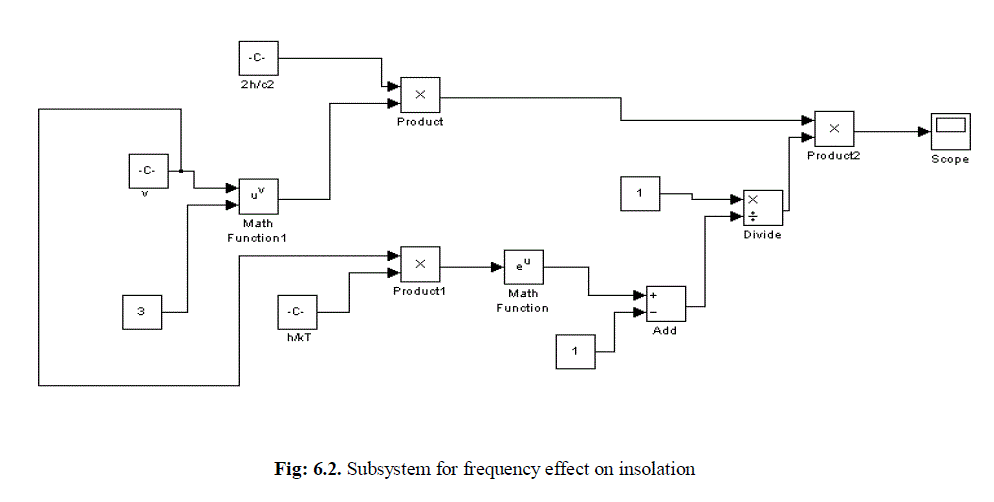 |
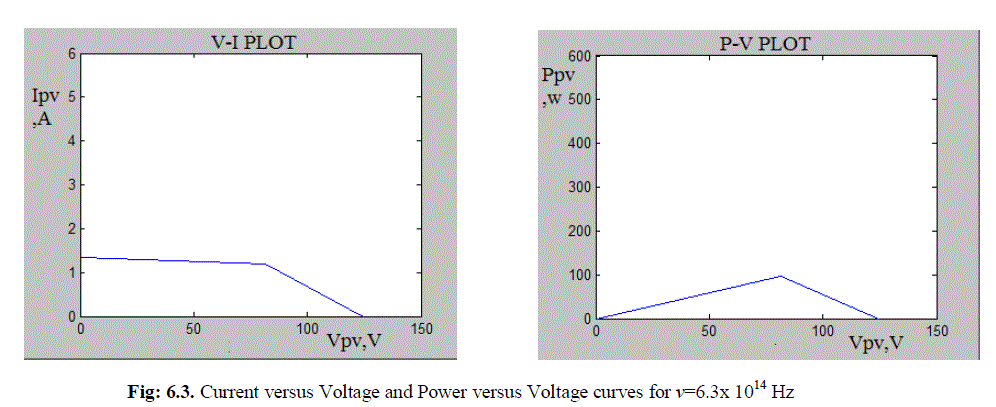 |
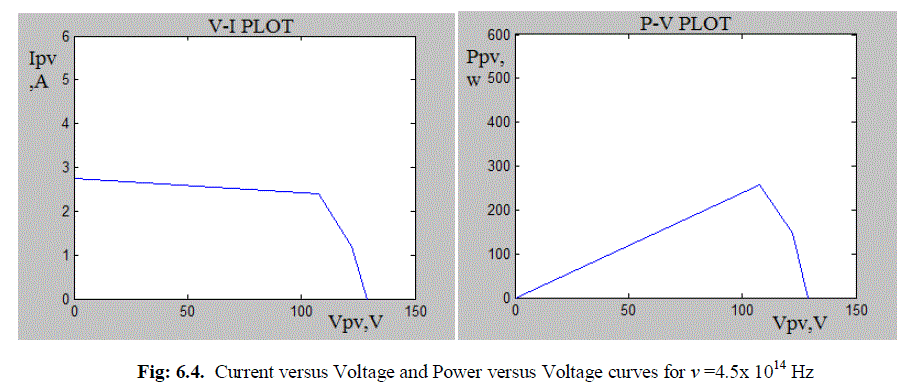 |
| Thus after the addition of optical filter it is possible to vary the frequency or wavelength of solar radiation, which in turn varies the insolation and hence efficiency. |
CONCLUSION
|
| The objective of this paper is to enhance the efficiency of Photovoltaic panel. A non-pressurized cooling system was developed for cooling the panels with least amount of water and energy. A low cost solar tracking have also been incorporated to maintain better solar insolation. It can be concluded that; |
| 1. It is possible to cool and clean the PV panels using the proposed cooling system in hot and dusty regions. |
| 2. It is also possible to provide low cost solar tracking for real time applications. |
| Future scope of this project is that the optical filters can be used to reduce reflection losses caused by unwanted radiations thereby allowing only useful radiations to reach the solar wafer. This methodology can be used to develop PV modules to absorb a particular wavelength of light from solar radiation in order to improve efficiency. |
References
|
- Martin P. Bates, ‘Interfacing PIC Microcontrollers- Embedded Design by Interactive Simulation’, Elsevier, 2006.
- Moharram.K.A, M.S. Abd-Elhady, H.A.Kandil ,H.El-Sherif (2013) ‘Enhancing performance of solar photovoltaic panel by water cooling’, Ain shams engineering Journal, Vol.4, pp.869-877.
- Rustemli.S, Dincer.F. (2011) ‘Modeling of Photovoltaic Panel and Examining Effects of Temperature in Mat lab/Simulink’, Electronics and Electrical Engineering, ISSN 1392-1215, No. 3(109), pp. 35-40.
- Savita Nema, R.K. Nema, GayatriAgnihotri (2010) ‘MATLAB/Simulink based study of photovoltaic cells / modules / array and their experimental verification’, International journal of Energy and Environment, Vol.1, No.3, pp.487-500.
- TarakSalmi, MounirBouzguenda, Adel Gastli, Ahmed Masmoudi (2012) ‘MATLAB/Simulink modeling of solar photovoltaic cell’, International journal of RENEWABLE ENERGY RESEARCH, Vol.2, No.2
- Tiwari .G. N., Swapnil Dubey, ‘Fundamentals of Photovoltaic Modules and Their Applications’, Royal Society of Chemistry, 2010.
|